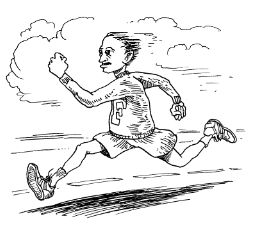I. We Need Short Shorts.
There is a lie that cross-country coaches tell their distance runners. “Running is a team sport,” they say. “Even though it can seem like you are out there by yourself, you have to train as a team, support each other as a team, work as a team. Running is not a solitary sport.”
A big lie. Running, like swimming events, like weight-lifting or gymnastics, is a solitary sport. That you might interact with other people during training, that there might be social aspects to practice, is rather beside the point. Training for an athletic contest is almost by necessity social—any exception will tend to attract very weird participants: consider competitive eating—but the fact that the runner sees other people now and again, even every day, does not change who he is, or what he does. He is a loner, and he runs alone.
I say “he” because my subject is the specific kind of boy who takes up running, and he is very different from the girl who is his counterpart. This boy, whom I know well, is just not good at any other sport. He may have tried baseball, but could not throw; he may have tried soccer, but could not kick. He is not coordinated or strong or big. So he runs.
No American eight-year-old thinks it would be cool to be a distance runner someday. If he becomes one, it is not the realization of a dream, but the acceptance of reality.
That the average American running boy is the anti-jock is just as well; the preening, performing lacrosse egotist will not receive the necessary public affirmation from distance running. In cross country, even championships are a bit disheartening, even when you win. There is no World Series–style pile-on. And there will be no cheering, for cross-country running takes place almost entirely out of sight of the fans, who can see the action only at the starting and finish lines. And, therefore, there are no fans, save the runners’ girlfriends. But they have no girlfriends, because they are runners.
Or perhaps they are runners because they have no girlfriends.
Either way, it is completely understandable why Michael Cera, the Canadian actor who plays varsity runner—and unwitting baby-daddy—Paulie Bleeker in the 2007 movie Juno, has become the premier runner in contemporary filmdom. It has been argued that he plays the same character in every movie; in a bitchy article in Wired magazine, the writer accuses Cera of always playing a “horny, awkward teenager.” One online commentator, the pseudonymous “sevenwords,” puts the ultimate charge fairly bluntly: “Dude plays the same socially awkward teenage dork in every movie. Time to change...
You have reached your article limit
Sign up for a digital subscription and continue reading all new issues, plus our entire archives, for just $1.50/month.
Already a subscriber? Sign in





